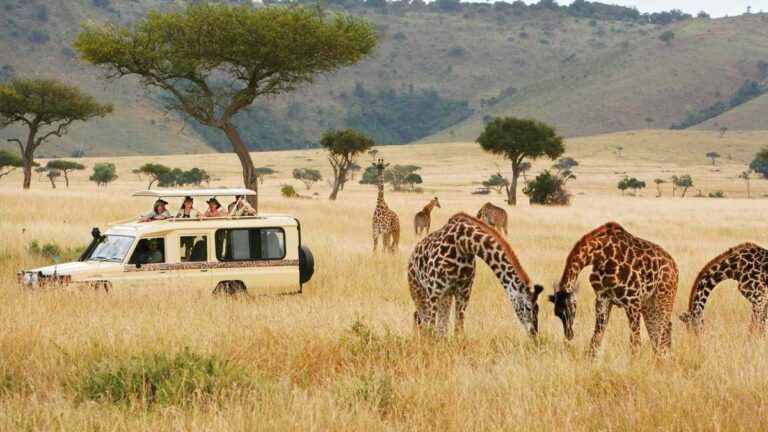Nairobi National Park
Discovering Nairobi National Park: A Jewel in the Heart of Kenya
Nairobi National Park, one of the world’s most unique wildlife reserves, holds a special place in the hearts of both locals and international visitors. This remarkable park is situated just a few kilometers from Nairobi’s bustling city center, offering a rare opportunity to experience African wildlife amidst the backdrop of a vibrant metropolis. Let’s explore the history, growth, and challenges of Nairobi National Park, and why it remains a must-visit destination for safari enthusiasts.
The Origins of Nairobi National Park
Nairobi National Park was established in 1946, making it Kenya’s first national park. Its creation was driven by the vision of wildlife conservationists who wanted to protect the region’s rich biodiversity while accommodating the growing city. The park covers an area of 117 square kilometers (45 square miles) and is unique for being the only national park in the world located so close to a major city.
When the park was first established, its primary purpose was to conserve wildlife species such as zebras, giraffes, and lions, which had once roamed freely across the Nairobi area. Over the years, Nairobi National Park’s boundaries expanded to include more diverse habitats, from savannahs and wetlands to forests, allowing it to support an even greater variety of wildlife.
Growth and Conservation Success
Since its establishment, Nairobi National Park has grown in importance as a hub for wildlife conservation, education, and eco-tourism. The park has become home to a wide range of species, including the endangered black rhino, which is one of its star attractions. Visitors to the park can spot the Big Five : Lions, Leopards, Elephants, Buffalo, and Rhinos, without leaving the city.
The Nairobi National Park is also part of several wildlife corridors that connect it to other protected areas in Kenya. This connectivity has played a vital role in ensuring the park’s continued growth and the preservation of wildlife populations. Over the years, efforts to restore and expand the park have seen an increase in its wildlife populations, making it a prime destination for eco-tourism and conservation projects.
Key Attractions in Nairobi National Park
- The Nairobi Animal Orphanage: A sanctuary for orphaned or injured wildlife, where visitors can get up close to various animals.
- The Nairobi Safari Walk: An educational boardwalk where visitors can learn about Kenya’s diverse ecosystems and conservation efforts.
- The Black Rhino Sanctuary: A dedicated area for the conservation of the endangered black rhino, one of the park’s main conservation successes.
Challenges Facing Nairobi National Park
Despite its success, Nairobi National Park faces several challenges that threaten its future. As the city of Nairobi continues to expand, encroachment on the park’s boundaries and human-wildlife conflict have become significant issues. The growing population and infrastructure development pose a direct threat to the park’s wildlife habitats, making it increasingly difficult to balance urbanization with conservation efforts.
In addition to this, poaching and illegal wildlife trade remain a concern for park rangers and conservationists. While Nairobi National Park has had significant success in protecting its wildlife, especially the black rhino, maintaining security and enforcing anti-poaching measures is an ongoing challenge.
Another challenge for Nairobi National Park is the need for increased funding to sustain its operations and conservation programs. While the park benefits from its popularity as a tourist destination, the funds generated must go back into the park for wildlife management, anti-poaching efforts, and habitat restoration.
Looking Ahead: The Future of Nairobi National Park
As Nairobi National Park continues to grow in both size and significance, the future of the park looks promising, though it depends on collaborative efforts from the government, conservation organizations, and local communities. Ongoing conservation programs, increased awareness about the importance of the park, and sustainable tourism practices are essential for ensuring that this urban wildlife oasis remains a sanctuary for future generations.
Nairobi National Park represents a unique blend of urban and wildlife conservation, providing a rare glimpse into the harmony that can exist between nature and city life. As it continues to evolve, the park’s role in wildlife conservation will remain pivotal for both Kenya and the world.
Why Visit Nairobi National Park?
- Proximity to Nairobi City: You can experience a safari without leaving the capital city.
- Diverse Wildlife: Spot the Big Five, including the endangered black rhino.
- Educational Experience: Learn about conservation, wildlife protection, and Kenya’s ecosystems.
- Unique Safari Experience: A chance to view wildlife with Nairobi’s skyline in the background, an experience unlike any other in the world.
Whether you’re a first-time visitor or a returning safari enthusiast, Nairobi National Park offers something for everyone. It’s not just a park; it’s a symbol of how urban spaces can coexist with nature, making it an essential stop for travelers looking to experience Kenya’s wildlife up close.





